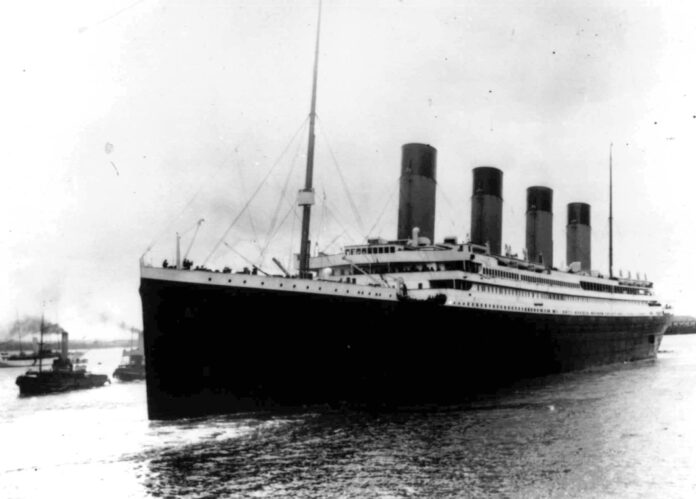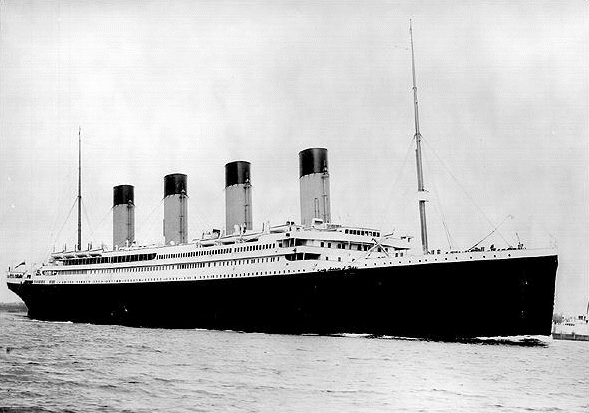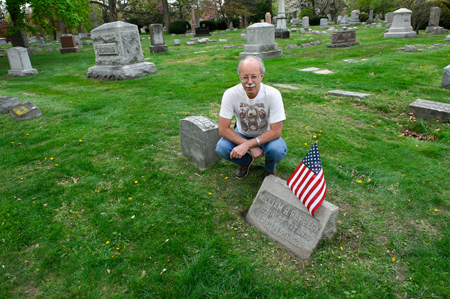When the Atlantic Ocean swallowed all 46,328 tons of Titanic, a poor immigrant sat waiting thousands of miles away for her fiancé to join her at their new Toledo home.
She would never see him again.
Another local woman would soon have to identify her husband’s body — only to learn that he shared the last hours of his life with a mistress.
A woman who convinced her brother-in-law to visit her from England would discover she inadvertently coaxed him to his icy death.
And in Fremont, beet farms would forever lie waiting for the hands of workers from Belgium to unearth their produce.
The ship sank thousands of miles away but Northwest Ohio felt the waves.
Chaos through a porthole
The death and wreckage washed up in the nightmares of some Toledo residents for their entire lives. The sight left one woman, Flora Posan, almost too terrified to travel overseas again to visit her Hungarian parents.
Posan was born outside of Budapest, Hungary, and moved to Toledo with her husband and children for factory work. When her second husband died in an iron works accident, Posan, her sister and her three children boarded Carpathia to voyage to her homeland.
They never made it there. Instead, they ended up back in New York City with a ship full of heartbroken Titanic survivors and the ghosts of those who lay down to die on the Carpathia’s decks.
“The deck was a scene of chaos,” Posan told a relative during an interview conducted later in her life.
Posan’s grandson Jerry Bascuk lives in Maumee. He said she was a strong woman — she outlived three husbands, raised four children, endured the death of one and witnessed the human carnage of Titanic’s demise.
Posan and her family traveled in Carpathia’s steerage. She watched from the porthole of the deck at about 1 a.m. She saw lifeboats overturn, tossing 16 women and children into the water to drown.
Many of those pulled aboard Carpathia died on the deck, she said.
“The next morning I watched them bury some of them,” she said. “They put the bodies on planks, the priests came by and spoke over them and they dropped them in the water. I was young then and I watched them do it; I wouldn’t do it today.”
Posan was 25 years old at the time. Bascuk said he found during his research that Posan traveled to Hungary in 1914, but the incident with Titanic left her hesitant to commit to any further sailing. She stuck to her East Toledo home in the Birmingham neighborhood for the rest of her life. She raised chickens in her backyard and grew much of the family’s food in her garden. Bascuk, who lived with her during part of his childhood, remembers little rewards he’d receive for shoveling coal — the occasional 50-cent pieces waiting for him downstairs in the mornings.
Posan’s sister Barbara told Toledo News-Bee that she saw things that she’d never forget.
“We would like very much to see our father and mother again before they die,” she told a reporter through an interpreter. “They haven’t long to live. But my sister and I wouldn’t cross the ocean now for all the money in the world.”
Lost life, lost love
Others from Toledo would never get to make that choice.
Karl Harbeck, of Blissfield, Mich., has done a lot of digging to learn about his distant relative who died when Titanic sank. That relative, William Harbeck, had two children but they never had kids. Fortunately for Karl, researching him wasn’t too difficult because he was fairly famous.
William made movies. He was once the deputy sheriff of Lucas County. He marketed the 1890s version of Viagra, he ran a laundry business and edited a newspaper in Colorado. The Toledo native had his hand in a little bit of everything at the turn of the century.
Born in the 1860s (his exact birth date is disputed because it was recorded differently by various sources), William was the son of Lucas County Sheriff John Harbeck. After stints as the deputy sheriff and a laundry business manager, William sold “Long Life Sexual Power Wafers” from his Downtown office on Superior Street during the 1890s. These $3 packages would help “weak and impotent men and women secure healthy, powerful and vigorous development,” according to a pamphlet Karl found on eBay.
William’s film career took off in the late 1890s. He was one of the first motion picture photographers to catch the 1906 San Francisco earthquake on film. He worked as the official photographer of the Canadian Pacific Railroad. He worked for a company called Hale’s Tours that commissioned him to film cities and tourist attractions. The job took him to Yellowstone National Park, to Vancouver, Canada, and various other cultural hot spots. His career ultimately led him aboard Titanic, after he was hired to film the ship’s maiden voyage. He recorded events while en route and planned to depart from Titanic on a tugboat so he could film the ship’s arrival to the New York City harbor.
But the ship sank before that could happen. And all of his 110,000 feet of film went down with it. His body was found floating in a life vest.
William’s body was shipped to Halifax, Nova Scotia. When his wife Catherine arrived to identify the body, officials told her that records showed that his wife also died on the ship. She then learned that her husband had voyaged with a mistress — a French woman named Henriette Yvois. She was half his age. He booked her as his wife.
“One wonders what was going through her mind when she had his body picked up in New York and brought him back for burial and all of this came out,” Karl said.
Regardless, Catherine continued to maintain William’s other residence in Seattle to handle her husband’s film business, Karl said.
The Harbecks are buried at Woodlawn Cemetery. William’s faded gray headstone is slightly sinking into the ground, marked with the words “Victim of Titanic.”
On the lam or lost at sea?
Just 40 miles south, in Findlay, another family got word they’d lost a relative. The Yates family received a handwritten note indicating Jay Yates had perished on Titanic. He too was famous … but for different reasons. Yates was wanted for arrest in seven states.
Newspaper accounts described the man as a gambler, confidence man and fugitive from justice.
“Thank God, I know where he is now,” his mother told the Toledo News-Bee in April 1912. “I have not heard from him for two years. The last news I had from him he was in London. I spent nearly a fortune getting him out of trouble some years ago. Then he was charged with forgery.”
But perhaps she still did not know where he was. No one by his name, or his alias J.H. Rogers, was listed as a passenger on the ship. Some family members claimed to have thought they saw him after 1912 and many historians believe the note was a ruse.
But newspapers at the time reported that he went down with the ship.
An article from the Chicago Inter-Ocean reported that the man borrowed $1,900 by having another woman forge his wife’s name to a mortgage. Yates was also charged with stealing $2,700 in postal money orders, according to a 1998 Findlay Courier article.
When Titanic sank, newspapers reported that all that was left of him was a note, scribbled on a page torn from a diary and handed to one of the many women he supposedly helped board lifeboats.
“If saved, inform my sister, Mrs. J.F. Adams, of Findlay, O. Lost. — J.H. Rogers,” the note said.
According to the News-Bee, the woman who took his note mailed it to his sister in an envelope labeled “Survivor.” She wrote that she didn’t know Yates but that she thought he was a card player. Before her boat lowered to the water, she saw him jump into the ocean, she wrote.
She also noted that she thought he registered to the ship with a fake name.
Even if Yates was on board, some doubt he died in the Atlantic in 1912. The Findlay Courier article states that some family members believed, as of the 1990s, that Yates might have secured a lifeboat by disguising himself as a woman.
Destination NW Ohio
Northwest Ohio was the destination for many Titanic victims, according to Toledo News-Bee archives. There were the Vanderplanckes, a Belgian family seeking farm work and Henry Michael Mitchell, a 71-year-old retiree from Guernsey Islands, England, who intended to visit his sister-in-law in Toledo. And there was John Andonis of Hungary.
The Toledo News-Bee reported that a woman named Martha Kuskie moved to Toledo from Hungary in March 1912. She worked as a maid at the Madison Hotel. She and her fiancé had planned for him to join her in April so he bought a ticket to board Titanic to travel to the United States. Kuskie’s fiancé, a third-class passenger, was never found.
The Vanderplanckes were four of many Belgians taking Titanic to America. They perished, along with all but six of their fellow countrymen aboard, according to a 1998 article in Voyage, the journal of the Titanic International Society.
According to the article, the Belgians came primarily from two areas: Denderhoutem in East Flanders and Zwevezele in West Flanders. Many of them were recruited by travel agencies to work seasonal agricultural jobs. Much like migrant farmers today, they could save money and sail back home to share some of their earnings with their families.
A Fremont company attracted Belgians for this reason. The Toledo News-Bee reported that the Continental Sugar Company expected at least 100 Belgians en route to work in the company’s beet fields died when Titanic sank. Many of these employees had spent winters in Belgium and summers in America.
This was the case of the Vanderplanckes. Julius Vanderplancke, 31, was employed by the company for four years. He returned to Belgium in 1911 to marry Emilia Vandermootele of Pittem, Belgium. The couple boarded Titanic with Julius’ 18-year-old sister Augusta and her 15-year-old brother Leo. Another Zwevezele resident named Victor Vandercruyssen joined them, according to “Ohio Tales of the Titanic” by Janet White and Mary Ann Whitley, a Northeast Ohioan who is a copy editor at The Plain Dealer.
The group traveled in third class and their bodies were never recovered.
Another trip ended in tragedy for Henry Michael Mitchell. The 71-year-old retiree was on his way to visit his sister-in-law Anna Jeffery, of 1605 Collingwood Ave. Mitchell had originally booked a trip on Philadelphia, which would have left harbor April 6. But a coal miner strike rendered the ship incapable of traveling, so Mitchell’s ticket was transferred to Titanic, according to Whitley and White’s book.
Jeffery, a widow, reportedly never forgave herself for convincing her brother-in-law to visit her, according to Whitley and White’s book.
The guilt of Belfast
“Ohio Tales of the Titanic” includes information about the 55 Titanic passengers who were headed to Ohio. Twenty-eight of them died. Whitley and her co-author toiled for years, scouring census records and local history departments at libraries, conducting interviews and scanning any other documents that led to clues about passengers. Whitley described the last six months as nonstop. They finished just in time to release their findings before the 100-year anniversary.
Her dedication to the subject is rooted in her family history. Her grandfather Edward Whitley and his brother-in-law helped build the ship that sunk. Edward died when Whitley was young so she did not talk to him about his experience in Belfast, Northern Ireland, building Titanic. But she said her father, who was a young boy when the family moved to America, recounted his childhood overseas. The disaster left Belfast, where much of the ship was assembled, horror-struck.
“I think they almost felt ashamed in a way and felt that they were blamed that this ship that they built had caused this big loss of life,” she said.
Some 1,500 employees worked long hours to construct Titanic. Whitley’s grandfather, who was a machinist and worked on the ship’s engine, did not board the ship. One of his friends, Archie Frost, wasn’t so lucky. Frost was part of the troubleshooting team on board. He and the rest of the team didn’t make it, she said.
That guilt loomed for years, an unspoken sorrow harbored by so many who lived in Belfast. One of Whitley’s relatives told her his grandfather was evidence of this.
“(He) only cried about two things — World War II and Titanic.”

























